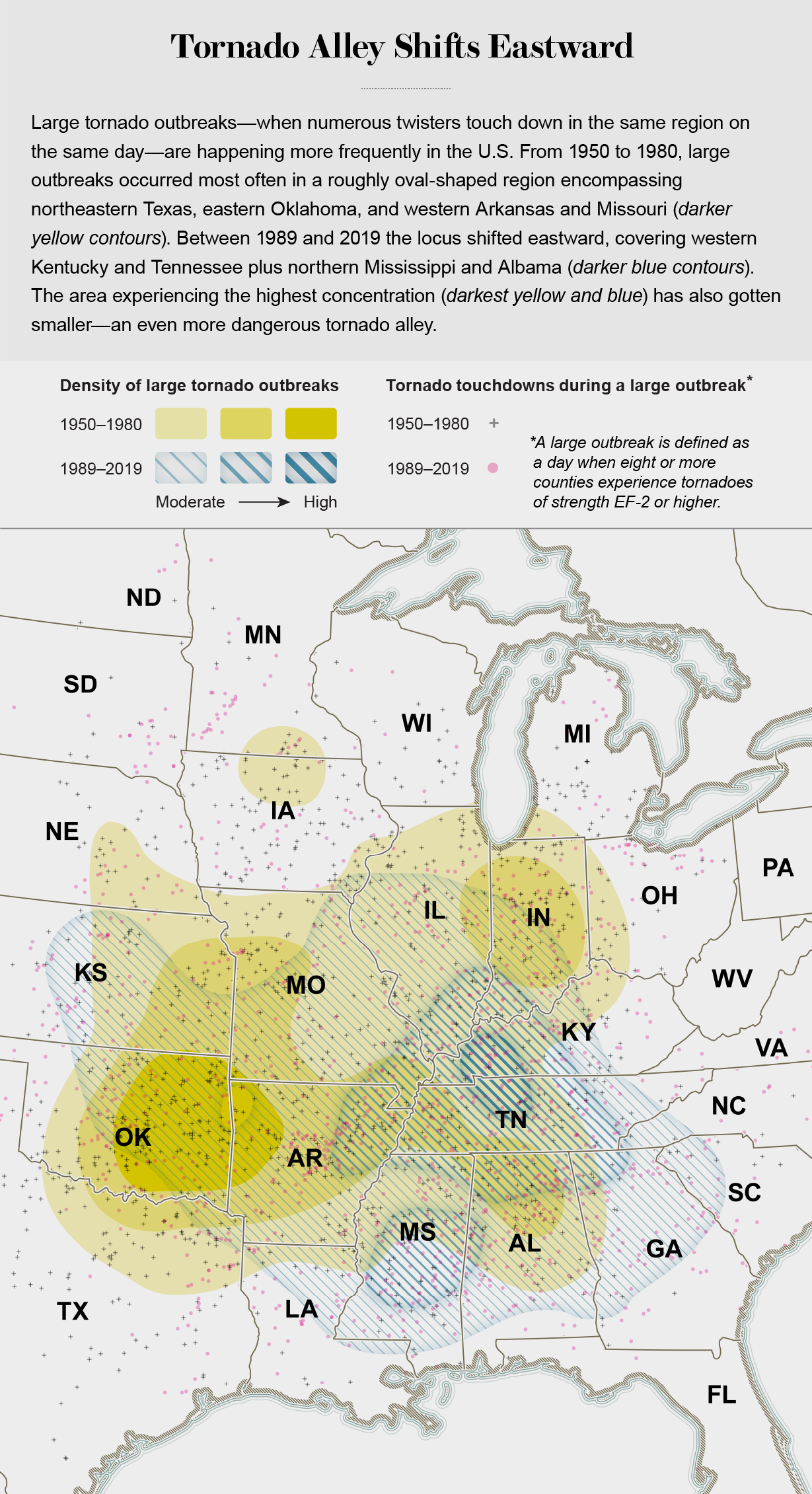Roughly 1,200 tornadoes strike the U.S. throughout a mean 12 months. They’re prevalent within the U.S.—way more so than anyplace else on the earth—as a result of its geography units up the proper situations, particularly in spring and summer season. Westerly winds from the Pacific Ocean drop their moisture after they push up over the Rocky Mountains, turning into excessive, dry and funky as they transfer farther east. Related winds could descend from Canada. In the meantime low, heat, humid air streams northward from the Gulf of Mexico. Flat terrain alongside these paths permits the winds to maneuver comparatively uninterrupted, at contrasting altitudes, till they run into each other. The angles at which they collide are likely to create unstable air and wind shear, two massive components that favor twister formation. Though considerably comparable air lots do conflict in different places, corresponding to Uruguay and Bangladesh, the forces are way more highly effective over the U.S. Canada ranks second worldwide with 100 twisters a 12 months.
Though tornadoes contact down in lots of locations throughout the japanese half of the nation, from the Fifties by means of the Nineteen Nineties they struck most frequently in Twister Alley, an oval space centered on northeastern Texas and south-central Oklahoma. Extra lately, that focus has shifted eastward by 400 to 500 miles. Prior to now decade or so tornadoes have grow to be prevalent in japanese Missouri and Arkansas, western Tennessee and Kentucky, and northern Mississippi and Alabama—a brand new area of concentrated storms.

Twister exercise in early 2023 epitomized the development. A violent tornado with wind speeds of 170 miles per hour struck Rolling Fork, Miss., on March 24, killing no less than 26 individuals. Every week later storms within the new twister alley killed greater than 30 individuals, and one other group on April 4 broken greater than 80 constructions in Bollinger County, Missouri. These occasions occurred in simply the run-up to peak season in April and Might.
Knowledge gathered up to now two years present that along with solo storms, giant twister outbreaks—a number of twisters spawned by a single climate system—are shifting much more definitively to the east. The swarms are clustering in a tighter geographical space than within the outdated Twister Alley, too. And outbreaks could also be getting fiercer and extra frequent. “It appears to be like as if we could also be having fewer days within the U.S. with only one twister and extra days when there are a number of tornadoes,” says Naresh Devineni, an affiliate professor at Metropolis College of New York, who co-led a 2021 geographical evaluation of enormous twister outbreaks.
Why is that this shift occurring now? Most frequently tornadoes are created by a supercell—a powerful thunderstorm with a rotating updraft of air. Supercells are likely to kind when heat, humid, low-level air interacts with cool, dry, upper-level air, and local weather change is producing hotter, moister air. Tornadoes additionally usually tend to develop when the native environment is unstable, “and warming will increase instability,” says Zuohao Cao, a twister knowledgeable at Atmosphere and Local weather Change Canada, who co-led a current research on storm landing areas. Local weather change is warming the Gulf of Mexico as properly, which might ship beneficiant quantities of water vapor into the southeastern U.S.
Analysis means that the so-called dry line can be shifting eastward. The imaginary line runs north from the U.S.-Mexico border as much as Canada, dividing the wetter japanese U.S. from the drier western U.S. (To the east, thirsty crops corresponding to corn predominate; to the west, drought-tolerant wheat prevails.) The road, which for hundreds of years has fallen roughly alongside the one centesimal meridian, has moved east by about 140 miles for the reason that late 1800s. The dry line “generally is a boundary for convection—the rising of heat air and sinking of colder air that may gas storms,” wrote Ernest Agee, professor emeritus of atmospheric science at Purdue College, in the Conversation in 2022.
Local weather change could prolong the standard twister season as properly. Milder winters imply the unstable air lots that may create supercells could grow to be extra possible in March and even earlier within the southeastern U.S.
Twister Alley shifting eastward is greater than a meteorological curiosity. The shift is critical: Twister shelters are widespread in Texas and Oklahoma however much less so elsewhere. The Southeast is extra densely populated, and cellular properties, which fare poorly in windstorms, are way more widespread. Tornadoes within the Southeast additionally happen at night time extra usually than they do farther west, partially as a result of winds can convey ample moisture from the Gulf after darkish. Research present that tornadoes that strike at night time are 2.5 instances extra more likely to trigger fatalities.
Native and state governments within the new bull’s-eye area would possibly wish to enhance neighborhood shelters and warning programs, strengthen constructing codes, higher equip emergency responders, and educate residents about what to do—and to not do—if a twister is headed their means.


